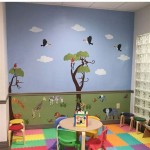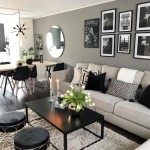Embracing Timeless Elegance: A Guide to Vintage Style Room Decor
Vintage style room decor evokes a sense of nostalgia, charm, and sophistication, transporting individuals to bygone eras. It is not simply about filling a room with antique objects; rather, it involves creating a cohesive and evocative atmosphere through careful selection of furniture, colors, textiles, and accessories. Understanding the core principles of vintage design is crucial for achieving an authentic and aesthetically pleasing result.
The term "vintage" can encompass a broad range of styles, generally referring to items that are at least 20 years old but not quite antique (which are typically over 100 years old). This means the vintage decor style can draw inspiration from the 1920s Art Deco era to the mid-century modern aesthetic of the 1950s and 60s, and even the bold patterns of the 1970s. The key is to identify a specific era or a harmonious blend of eras that resonate with personal preferences and create a consistent theme throughout the room.
Understanding Key Eras and Styles
Each decade and design movement within the vintage spectrum offers unique characteristics and aesthetic principles. Familiarizing oneself with these distinctions is essential for creating an informed and curated vintage space.
Art Deco (1920s-1930s): Characterized by geometric patterns, luxurious materials like chrome and velvet, and bold colors such as gold, black, and emerald green. Furniture often features streamlined shapes and intricate details. Consider incorporating elements like geometric mirrors, mirrored sideboards, and velvet upholstered chairs.
Mid-Century Modern (1940s-1960s): Defined by clean lines, organic shapes, and a focus on functionality. Furniture often features tapered legs, teak wood, and vibrant colors like orange, avocado green, and mustard yellow. Key elements include Eames chairs, tulip tables, and starburst clocks.
Hollywood Regency (1930s-1950s): A glamorous and opulent style inspired by the Golden Age of Hollywood. It features luxurious materials like velvet, satin, and fur, along with metallic accents, bold patterns, and dramatic lighting fixtures. Key elements include tufted sofas, ornate mirrors, and chandeliers.
Shabby Chic (Late 20th Century): A romantic and feminine style characterized by distressed furniture, pastel colors, floral patterns, and vintage-inspired accessories. It embraces imperfections and creates a cozy and inviting atmosphere. Distressed painted furniture, floral fabrics, and vintage lace are hallmarks of this style.
Choosing a specific era provides a framework for selecting furniture, colors, and accessories, ensuring a cohesive and harmonious aesthetic. Blending elements from different eras is possible, but careful consideration should be given to ensure they complement each other rather than clash.
Sourcing Authentic Vintage Pieces
Acquiring genuine vintage items is a crucial aspect of creating an authentic vintage room. While reproductions and vintage-inspired pieces can be incorporated, the unique character and history of original vintage items contribute significantly to the overall ambiance.
Antique Stores and Flea Markets: These are traditional sources for finding vintage furniture, accessories, and textiles. Patience and a keen eye are essential, as browsing through these establishments requires sifting through a wide variety of items. Negotiating prices is often customary.
Estate Sales and Auctions: Estate sales and auctions offer opportunities to acquire entire collections of vintage items, often at competitive prices. Thoroughly inspect items before bidding, as they may require restoration or repairs.
Online Marketplaces: Online platforms like eBay, Etsy, and Chairish provide a convenient way to browse and purchase vintage items from a wider range of sellers. Pay close attention to product descriptions, seller reviews, and shipping costs.
Consignment Shops: These shops typically offer a curated selection of vintage and pre-owned items in good condition. They can be a good option for finding specific pieces without having to sift through a large inventory.
When evaluating vintage items, consider their condition, authenticity, and historical significance. Minor imperfections can add character, but significant damage may require professional restoration. Researching the origin and value of items can help ensure a fair price is paid.
Creating a Vintage Color Palette and Texture
The color palette and texture of a room play a crucial role in establishing its vintage character. Each era has its own signature color schemes and material preferences, which should be considered when selecting paint colors, fabrics, and accessories.
Color Palette: Researching the popular colors of the chosen vintage era is essential. For example, the 1950s often featured pastel shades like pink, turquoise, and mint green, while the 1970s embraced earthy tones like avocado green, mustard yellow, and orange. Understanding the color trends of the period will help in selecting appropriate paint colors, wallpaper, and fabric patterns.
Wallpaper: Wallpaper was a popular decorating choice throughout the 20th century. Consider incorporating vintage-inspired wallpaper patterns, such as floral prints, geometric designs, or damask patterns. Reproduction vintage wallpaper is readily available and can add a significant visual impact to the room.
Fabrics: The choice of fabrics can greatly enhance the vintage feel. Velvet, satin, and brocade were popular choices for furniture upholstery and window treatments in earlier eras, while textured fabrics like tweed and corduroy were common in the mid-century modern period. Incorporating vintage-inspired prints, such as floral chintz or geometric patterns, can further enhance the look.
Texture: Introducing tactile elements through the use of various materials can add depth and visual interest to the room. Consider incorporating materials like wood, metal, glass, and natural fibers. Vintage furniture often features intricate carvings, ornate details, and unique textures that contribute to its character.
Layering different textures, such as combining a velvet sofa with a woven rug and linen curtains, can create a visually appealing and inviting space. Be mindful of the overall balance and avoid overwhelming the room with too much texture.
Incorporating Vintage Accessories and Details
Accessories and decorative details are the finishing touches that bring a vintage room to life. These elements add personality, character, and a sense of authenticity to the space. Careful selection of accessories can transform an ordinary room into a captivating vintage haven.
Lighting Fixtures: Vintage lighting fixtures, such as chandeliers, sconces, and table lamps, can add a touch of elegance and authenticity to the room. Consider incorporating fixtures from the chosen vintage era, such as Art Deco chandeliers or mid-century modern atomic lamps. Reproduction vintage lighting fixtures are also available.
Mirrors and Frames: Ornate mirrors and vintage frames can add a touch of glamour and visual interest to the walls. Consider incorporating mirrors with antique finishes or frames with intricate carvings. Vintage photographs and artwork can also add character and personality to the room.
Textiles and Linens: Vintage textiles, such as embroidered tablecloths, lace doilies, and patterned blankets, can add a touch of charm and nostalgia to the room. Consider incorporating vintage-inspired linens, such as floral print bedding or crocheted throws.
Decorative Objects: Decorative objects, such as vintage clocks, radios, typewriters, and telephones, can add a sense of authenticity and history to the room. Consider incorporating objects that reflect the chosen vintage era and your personal interests.
Greenery: Incorporating plants and flowers can add a touch of freshness and vitality to the room. Consider using vintage-inspired planters and vases, such as ceramic pots or glass bottles. Select plants that were popular during the chosen vintage era, such as ferns, succulents, or spider plants.
Arranging accessories thoughtfully is crucial for creating a balanced and visually appealing display. Group similar items together to create cohesive vignettes. Avoid cluttering the room with too many accessories, as this can detract from the overall aesthetic.
In essence, crafting a vintage-style room is a meticulous process that requires an understanding of historical design trends, a dedication to sourcing authentic pieces, and a careful consideration of color palettes, textures, and accessories. By embracing these principles, individuals can curate spaces that exude timeless elegance and reflect a deep appreciation for design history.
:max_bytes(150000):strip_icc()/final-w.-large-mirror-bb2c331d25e743968d5ec1fd926adf55.jpg?strip=all)
25 Vintage Bedrooms That Prove Decor S Worth

A Comprehensive Guide To Various Vintage Bedroom Ideas

20 Awesome Vintage Bedroom Design Ideas Glamourous Country Style

20 Totally Vintage Bedrooms For You Room Decor Decoholic

21 Antique Vintage Home Decor Ideas Extra Space Storage

A Comprehensive Guide To Various Vintage Bedroom Ideas

45 Sweet Vintage Bedroom Décor Ideas To Get Inspired Digsdigs

Modern Interior Design With Vintage Furniture And Decor Accessories In Style Bedroom Styles

17 Home Decorating Ideas For Mixing Modern Vintage Decor Extra Space Storage

10 Must See Antique Style Bedrooms Vintage







